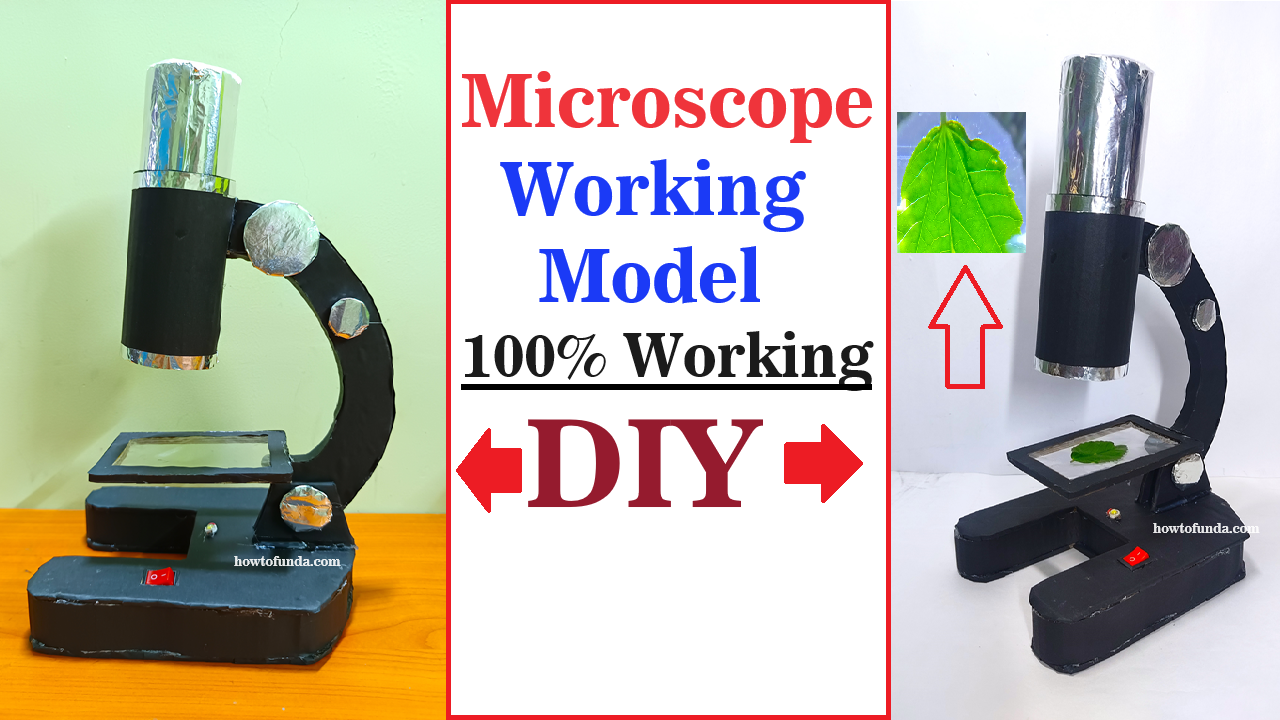Introduction
The purpose of creating a microscope model is to demonstrate the principles of magnification and optical science, allowing us to observe tiny objects that are not visible to the naked eye.
This project will help students understand how microscopes work and the importance of microscopes in scientific discoveries and everyday applications
How To Make The Microscope Working Model
Creating a working model of a microscope for a school science exhibition using cardboard, convex lenses, and chopsticks is a great project.
Here’s a step-by-step guide to help you build it:

Materials Needed:
- Cardboard: For the body of the microscope
- Convex lenses: For magnification (you can use lenses from inexpensive magnifying glasses)
- Chopsticks: For the adjustable arm and focusing mechanism
- Glue: Hot glue or strong adhesive
- Scissors/Cutter: For cutting cardboard
- Tape: Clear tape
- Ruler: For measurements
- Marker/Pencil: For marking measurements
Step by Step Video Instructions:
1. Design the Microscope Body:
- Base: Cut a rectangular piece of cardboard for the base (about 8×6 inches).
- Arm: Cut another piece of cardboard for the arm (about 12 inches tall and 2 inches wide).
2. Create the Stage:
- Cut a rectangular piece of cardboard (about 3×3 inches) for the stage.
- Cut a small hole in the center of the stage to allow light to pass through.
3. Body Tube:
- Cut a strip of cardboard about 10 inches long and 2 inches wide. Roll it into a cylindrical shape to form the body tube of the microscope.
- Secure the shape with glue or tape.
4. Lens Holders:
- Objective Lens Holder: Create a small box using cardboard to fit snugly at one end of the body tube. Cut a hole in the center to insert the convex lens. Attach the lens using glue or tape.
- Eyepiece Lens Holder: At the other end of the body tube, attach another convex lens using glue or tape.
5. Attaching the Body Tube:
- Attach the body tube to the arm at an angle, ensuring it is stable. Use glue to secure it.
6. Focusing Mechanism:
- Use chopsticks to create a simple focusing mechanism. Attach two chopsticks parallel to each other on either side of the arm, extending above the arm.
- Create a small platform (stage holder) that can slide up and down the chopsticks. This platform will hold the stage and allow it to move closer or further from the lens to focus.
7. Assembly of the Stage:
- Attach the stage to the stage holder. Ensure it can move smoothly up and down the chopsticks.
- Attach the chopsticks firmly to the base and the top of the arm using glue or tape.
8. Slide Holder:
- Create a small holder on the stage using cardboard to place your slides. This can be a simple rectangular frame that holds a small transparent sheet or a prepared slide.
9. Light Source:
- If possible, place a small LED light or use a flashlight to illuminate the sample from below. Alternatively, ensure your stage is transparent enough to allow external light to pass through.
10. Final Assembly:
- Assemble all parts together. Attach the arm to the base.
- Attach the body tube to the arm at an angle. Ensure everything is securely glued and stable.
- Position the stage so it can move up and down the chopsticks for focusing.
11. Testing:
- Place a sample slide on the stage.
- Adjust the stage using the chopsticks to focus on the sample.
- Use the light source to illuminate the sample.

